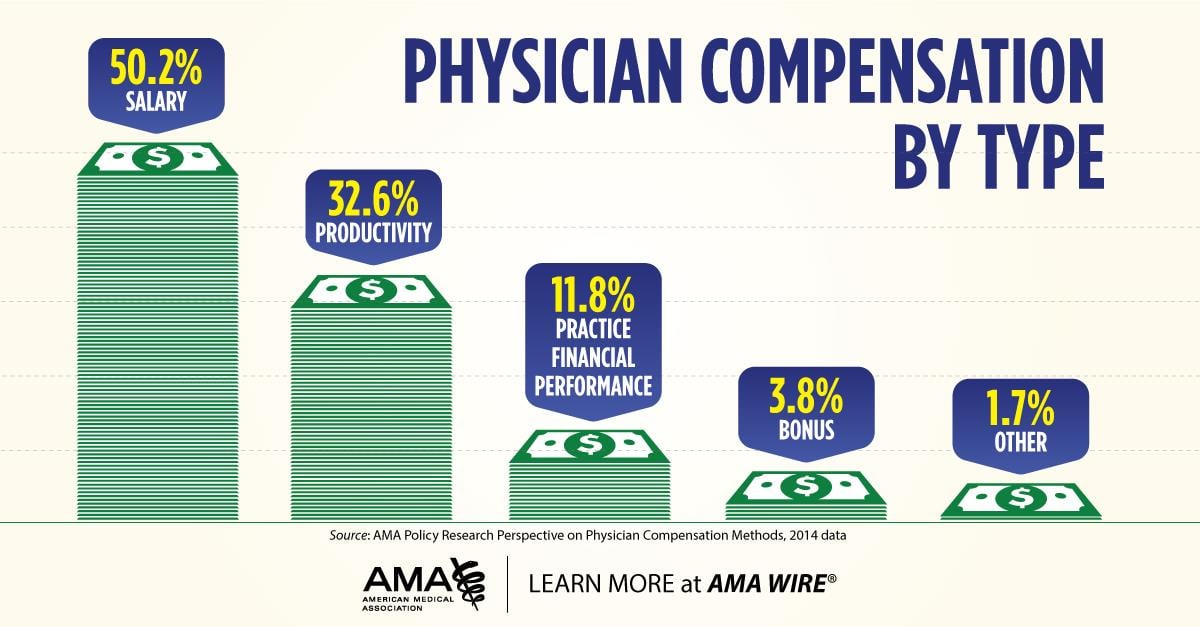RVU compensation is the most popular payment model. Physician Compensation Models.
 How Physicians Are Paid American Medical Association
How Physicians Are Paid American Medical Association
It is common for physicians employed by hospital groups and health systems to receive compensation in this way.

Physician compensation models. Current physician compensation models do not align incentives with the dynamic and unique strategic priorities of health systems especially in the face of unforeseen circumstances. Under this model a physician is compensated based on how productive he or she is personally which is commonly measured using work relative value units net charges or net revenues. Many independent physicians dont pay attention to wRVUs because they work under different physician compensation models.
Download a PDF copy to share with your team. Typically the physician is contracted to achieve defined levels of productivity and quality. The following is a brief synopsis of the pros and cons of the most popular physician compensation models.
These models should encourage and incentivize physicians to be more accountable for. There are a wide array of physician compensation models. Under this reimbursement model the organization receives money based upon an episode of care such as a hip or knee replacement which typically involves more than one physician more than one service and in some cases more than one.
A reimbursement model that determines physician compensation in a direct alignment with how the organization is reimbursed. January 3 2020 by Wes May. The path to finding the best physician compensation model will likely lead most employed networks to a Base Salary Plus Incentives Model that progressively incorporates a diverse evolving mix of individual and group productivity and non-productivity incentives aligned with organizational goals and objectives.
Promoting a team-based culture will lead employed networks to pursue non-productivity incentives within the physician compensation model. Types of Physician Compensation Models. This structure is easy to administer as the physician will be making the same amount each pay period without any fluctuation.
Advancements in the healthcare landscape have accelerated in the. There are a number of compensation models and incentives available to physicians practising in Ontario. The medical groups compensation is determined by the foundation model agreement and each individual physicians compensation is determined by the medical.
Using a preset level of income for physicians is the easiest model to understand. 1 production-based compensation 2 salary 3 group-based compensation unrelated to individual physician productivity and 4 capitation-based compensation. Physicians under such an arrangement will form an entity that contracts directly with the foundation for the provision of professional medical services.
Under this model the physician will receive a pre-arranged and fixed salary. The statistics and the economic incentives of different compensation methods are presented. This model incentivizes physicians to reduce expenses and increase their effort but does not support the change from fee for service to value-based care.
Practices should start thinking about transitioning to compensation models that incorporate strategies designed to meet the new patient care accountability standards retain existing physicians and stay competitive in their physician recruiting efforts. Revenue Less Expenses A common model in private practice is determining total compensation based on the physicians share of the total practice revenue less their share of the total practice expenses. In last years report primary care physicians PCPs earned an average of 237000 compared with 243000 this year a 25 increase.
Guide to Understanding Physician Compensation Models. TiPS Compensation Incentives and Benefits module offers new graduates and established physicians an overview of the types of compensation and incentives available to Ontario physicians along with links to additional. Four categories of physician compensation models are identified.
On the plus side capitation rewards groups and in turn those groups individual physicians who deliver cost-efficient effective care. Translated into a compensation model capitation involves distribution of health plan payments among physicians in a nearly equal manner or based on some type of formula.
